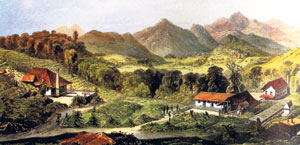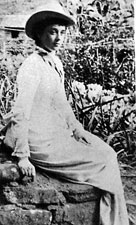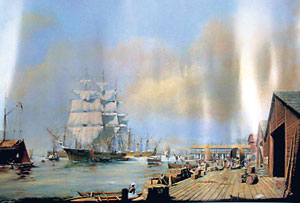The story of tea is best told by a planter. For who else would wholly understand the subject as he does. The value of this handsome book is in its descriptive power for John Weatherstone who was a tea planter in Ceylon in the 1950’s, following on his first successful tea book, The Pioneers, brings alive the travails and trials that lay behind the cup that cheers in this book, ‘Tea – A Journey In Time’.
Lavishly illustrated, the story goes a long way back, indeed to the 6th century “when the Emperor of China and his court drank a special tea which was harvested from truly wild tea that grew so tall that the leaves could only be picked by monkeys”.
 |
| Early days: Peacock Hill coffee estate, Gampola (Lithograph 1964 from O’ Brien’s
Views in Ceylon) |
Tea has been an integral part of this country’s recent history. But as the book details Ceylon was not the only country that the British bequeathed this legacy. Indeed India, where the East India Company which played a major role in the expansion of the tea industry was based, had a proud history of tea too.
Weatherstone, who hails from a family of planters who lived in the East from the 1880s’s tells the story with passion, making it a journey of discovery for the reader.
From how China exported tea to Russia in the 17th Century sending the chests of tea in tea caravans, two to three hundred camels snaking their way across the vast Gobi desert, we move to Japan where tea growing took root and see its incursion into Europe in the 17th century. The early British immigrants to the United States took the habit of tea drinking along with them when they crossed the seas. The story is told too of the infamous Boston Tea Party -the turning point which saw coffee supplant tea in the hearts of the American public.
Enter the East India Company, with that formidable fleet of over one hundred vessels. Initially involved in carrying China’s tea to Europe, the Company which ruled vast territories on behalf of the British sovereign soon saw the potential in growing tea in its own colonies and was prepared to take on China as a tea producer .
Weatherstone tells a fascinating tale of how the company that knew nothing about tea entered the fray: “The average Englishman at home would hardly have known the whereabouts of Assam – had he thought about it at all- and the North East Frontier smacked of fever-ridden jungle and warlike tribes – an assumption not far from the truth”.
Why Assam? Because it was here that a major in the Bengal Artillery was informed by native chiefs of tea plants growing wild and took it upon himself to send specimens to the Governor General. These were finally deposited at the Royal Botanical Gardens in Calcutta. Nothing emerged from this discovery until ten years later another soldier found similar tea plants.
 |
| White women were as rare as white
elephants |
This time they were properly identified.
How Assam, home of the Naga hill tribesman was opened up to tea by the British is a long story but the upshot is that 80,000 China tea seeds brought to Calcutta were germinated in the Botanical Gardens and the young China tea seedlings, some 20,000 of them then despatched on a river journey of 1000 miles up the Brahmaputra to Assam. Success did not follow as it was found that this seed was better suited to the higher areas of Darjeeling but suffice to say the British discovered the potential in the crop and took it on from there.
The Ceylon tea story is indeed too well known to recount here but Weatherstone’s account brings alive the pioneering spirit that characterised the early coffee planters- those intrepid men who braved jungle and river and torrential downpours to stake their claim on the land.
He recounts the tale of the three Coombe brothers who went from Colombo to Poonagalla, 130 miles away with one horse between them, taking it in turns to ride and walk.
When in 1869, a leaf disease struck and spread with devastating effect, it destroyed 331 million tea bushes in 276,000 acres. All this was subsequently replanted with tea, but not before cinchona had also been attempted. James Taylor, Weatherstone recalls, pioneered both cinchona and tea. Taylor planted 19 acres of tea and experimented with the manufacture in his bungalow- the green leaf brought in from the fields first withered and hand rolled on his own verandah.
“By the turn of the century and after a tremendous battle by the planters, 380,000 acres of tea was growing beautifully. Land on which the elephant, leopard, elk, bear and wild boar had roamed was now orderly, well established with tea.”
It was a hard life and the many old etchings, drawings and pictures paint a vivid scene. A photograph dated 1881 shows an Englishwoman in hat with the caption that “in the pioneering days, white women were as rare as white elephants, but there were exceptions”.
Tea was largely transported to Colombo and we learn how after the 1958 race riots and strikes, tea was dispatched to the Trincomalee harbour. Lorry drivers called the stretch of road between Habarana and Trinco, the Elephant Run.
Elephants also strayed into the hill country plantations and among the vignettes Weatherstone provides is the account of the tusker in the tea at Poonagalla which made it to the Loris, nature journal.
From Ceylon, the book moves to the start of the industry in the other big players today, with chapters devoted its growth in countries like India, Bangladesh, Malaysia, Kenya, before returning to the modern-day Sri Lanka in estates like Great Western, Rothschild and Poongalla, the latter where ghost stories still haunt.
An account by Joan Gottelier, a planter’s wife relates the night when her son Michael had seen a tall stooping man with white hair walking in the passage with a walking stick, followed by a little dog. The description exactly fitted R.G. Coombe, a former inhabitant of the bungalow before their time who used to walk his wife’s little dog after her death every evening. Also seen by the Gottelier’s Tamil cook was the ghost of a Coombe daughter who had died of typhoid aged 17.
The book is comprehensive and lovingly wrought- for the enjoyment of all- tea buffs notwithstanding who enjoy a good read. The author meanwhile lives in quiet retirement in the village of Shanklin in England, sans computer, email, fax or mobile phone, enjoying no doubt, the best of cuppas.
Clipper Tweed docks in Colombo
The year is 1888. The ship in the Colombo harbour is the elegant clipper Tweed which called in on Colombo on her way to New York. The Tweed was originally a Punjab paddle steamer built in Bombay that served in the Persian war and the Indian mutiny. In 1862, the Punjab’s paddle wheels and 10 8-inch 68 pounder guns were removed and she was converted to sail as the Tweed.
 |
| The oil painting by S.R. Fever |
“Much is known of the ‘China Tea Trade’ carried on by the famous tea clippers during 1860s to 1880s but little is recorded or illustrated of the early beginnings of the Great Ceylon Tea Trade’ which was very quickly to replace the tea from China before the turn of the century, Weatherstone writes.
The harbour as seen in the oil painting by S.R. Fever in 1974 has bullock carts arriving with tea, a far cry from the modern port, and the container ships of today.
“Tea transport from the Celestial Empire to the Western world was first made by the grand but cumbersome merchantmen of the Dutch and English East India Companies, then by sleek and elegant clippers which were, in turn, superseded by the steamers; nowadays our tea is brought in the container ship- an incongruous sight at sea, if ever there was one,” writes Weatherstone in a poignant elegy to the passing times. |



